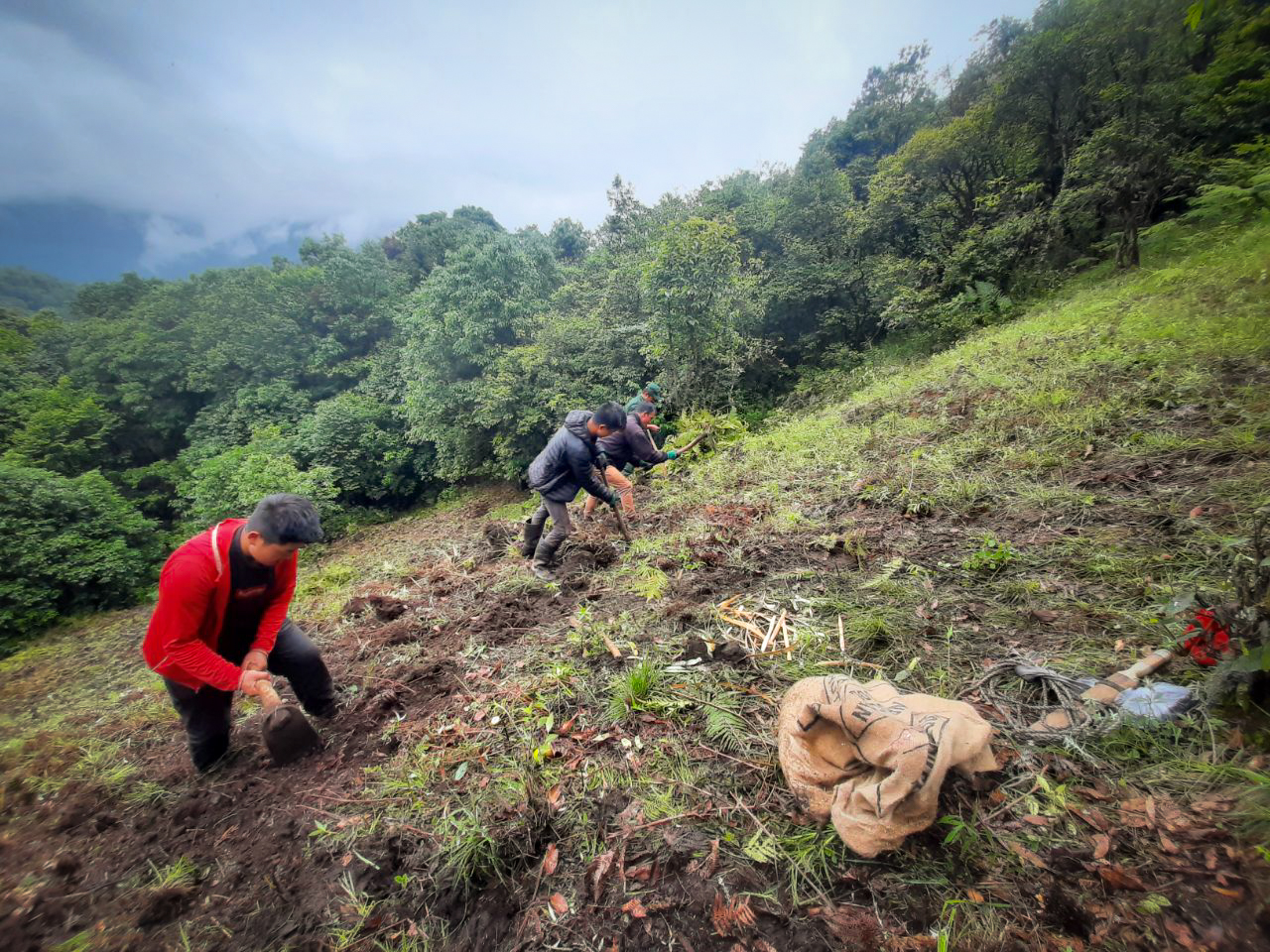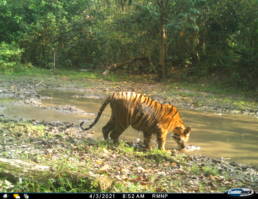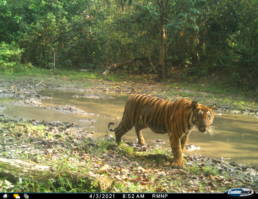29 July 2021

We love tigers. They are part of our heritage, culture and landscape. We believe tigers consecrate and sanctify our landscape, so we respect them. But we’re reliant on our livestock to make a living. When a tiger kills our
livestock, we lose our income. This is a huge problem in our communities.
Pema Lhamo Magmi,
community leader from Nubi Gewog
(an administrative unit consisting of a cluster of villages in Bhutan)
Resolving this dilemma for the hardy farmers and herders of cattle and yaks in mountainous Bhutan that graze their animals at altitudes of up to 4,800 metres in summer is a problem that the United Nations Environment Programme (UNEP) Vanishing Treasures programme is seeking to address through innovative grassland and water hole restoration activities in eastern and central Bhutan.
The programme is important for local communities and their livelihoods but is also globally relevant: the Royal Bengal tiger is an iconic endangered species, and ecosystems restoration experiments in a mountainous area may lead to important lessons for reducing human-wildlife conflict in similar regions.
Restoring mountain ecosystems
Restoring mountain ecosystems helps increase the resilience of mountain habitats, reduce the risk of disasters, generate recreation space, and ensure food and water security for local communities and beyond. The Bhutan Tiger Center, under the Department of Forests and Park Services, Ministry of Agriculture and Forests, Royal Government of Bhutan, is working with local communities in Trashigang and Bumthang Divisions to execute the programme, thanks to funding from the Government of the Grand Duchy of Luxembourg.
There are several direct and indirect threats facing tigers in Bhutan, one of which is the reduction of grassland. This is an example of an indirect threat, partly caused by farmers changing agricultural practices and a phenological shift (changes in biological life cycles) caused by climatic changes.
Earlier farming practices had an element of pastoralism and integral swidden systems (land clearing for temporary cultivation) that contributed to open grasslands through intermediate disturbance. Many grasslands are now turning into shrub and forest landscapes, reducing food availability for ungulates (animals with hooves).
While tigers are generalists and can live in a variety of landscape types, they are highly dependent on the availability of these ungulates as prey, meaning that this interlinkage of societal and climatic changes are indirectly impacting the tigers´ livelihood.
Most of our nomads’ settlements are around 4,000 metres above sea level. At around this altitude, the number of yaks has decreased as there are fewer nomads practicing this kind of lifestyle today. Without ungulates to nibble away at small bushes and tree saplings, what was grassland is reverting to thick bush and scrub.
Jamyang Dorji,
community leader from Samkhar Gewog in Trashigang
Climate change further exacerbates this problem (higher temperatures are leading to more rainfall and more plant growth). This is not good news for wild ungulates that depend on grasslands.

Climate change impacts on local communities
A recent survey carried out by the Bhutan Tiger Center in the two Vanishing Treasures programme areas (sample size 1,098) found that 87 per cent of respondents had observed more frequent shifts in weather patterns, including rain and snowfall.
Climate change in the Vanishing Treasures programme areas is increasing the risk of forest fires, droughts and water availability, as well as flooding, with the potential to disrupt livelihoods. Changes in cropping seasons, flowering and fruiting times could lead to the emergence of new pests, diseases, and the spread of invasive species. To adapt to the changing climate climate-smart farming practices and new livelihoods may, therefore, need to be developed.
Grassland restoration in Bhutan. © DoFPS.
Most of our grazing land and pasture are at altitudes of 2,000-3,500 metres above sea level. Human-tiger conflict has become more severe in the region over the past few decades. People who previously engaged in a semi-nomadic, pastoralist lifestyle herding cattle have drifted into towns to find more lucrative employment.
There used to be more than 20 pastoralists from my village alone a few decades ago with each having more than 100 cattle, but now we have only two households practising this kind of lifestyle. With fewer cattle to feed on encroaching bushes and shrubs, grassland suitable for cattle has diminished and some grazing grounds and pastures are completely gone.
This also affects wild ungulates like sambar deer, barking deer, serow (a goat-like mammal) and wild pigs. Many of the remaining patches of grassland are near homesteads, prompting wild ungulates to come closer to human settlements in search of food. Tigers follow them to the settlements, leading to more human-tiger conflict.
Ap Tshewang La,
who still practices the seasonal movement of livestock between summer and winter
In recent years human-tiger conflict has increased in Trongsa district, the programme area in central Bhutan where about 20,000 people live. Since 2016, more than 600 cattle have been killed by tigers, including 137 since the beginning of 2021, creating serious economic problems for the villagers.
The Bhutan Tiger Center estimates there are 40-50 Royal Bengal tigers in the programme area, out of a total of 103 in the whole country, according to a 2015 estimate.
Bhutan is committed to the conservation of tigers and we are doing everything we can to conserve this iconic species. Today, the greatest threat to tigers in Bhutan is the human-wildlife conflict that undermines our conservation efforts. Our Department is happy that the Vanishing Treasures programme is working with us to address the critical issues of human-wildlife conflict and climate change.
Lobzang Dorji,
Director, Department of Forests and Park Services,
Ministry of Agriculture and Forests, Royal Government of Bhutan.
Why grassland restoration?

Grassland restoration increases the area of grazing ground for both livestock and wild ungulates. Tigers tend to stalk and ambush their prey where they can hide among bushes, so the danger of tiger predation is greater when cattle stray into scrubland in search of fodder. Clearing scrub and bushes reduces predation by tigers.
These grasslands are also feeding grounds for wild ungulates and if they have enough food, they will not come near the settlements and villages.
This, in turn, means tigers do not follow these prey species to nearby settlements, making human-tiger conflict less likely. Patches of restored grassland allow cattle herders to graze cattle further from their villages, and rotate grazing from one patch to another to allow regrowth. This patchwork landscape of grassland, forest and scrub helps farmers and wildlife to coexist.
Grassland restoration is a community effort together with local forestry and livestock officials. Herders and farmers identify locations which were once grassland and need to be restored. Communities decide which grass species are sown in the cleared patches of land. Good quality pasture is vital for quality livestock products, incomes and livelihoods as well as for the wild ungulates. Local communities manage these grasslands through seasonal grazing and wild ungulates graze on them throughout the year. Clearing shrubs and bushes every 10-15 years would be sufficient to maintain these grasslands, according to the Bhutan Tiger Center.
As part of the Vanishing Treasures programme, around eight hectares (20 acres) of grassland have been restored since 2019. Another eight hectares of grassland is being managed in Trongsa. This doesn’t sound like much, but restoration is labour-intensive work. Thick bushes and small trees are cleared by local volunteers – and given that access to areas targeted for restoration can involve a several-hour walk, eight hectares represents a good start. Ultimately the aim is to restore 100 hectares of grassland.
Highlanders in Serpang, Trashigang Division, 4,800 metres above sea level, rely on grassland for their cattle, yaks and ultimately their livelihoods. As herders take their livestock higher up the mountains in search of pasture away from settlements, the risk of predation by tigers, snow leopards, common leopards and wild dogs increases. This increases the chance of conflicts between humans and carnivores. Hence, improving and restoring grasslands prevents human-carnivore conflicts.
Restored water holes keep tigers away from cattle
During dry seasons, natural or artificial waterholes are crucial for both domestic animals and wildlife in Bhutan as elsewhere. Unlike other large cats, tigers enjoy spending time in the water, especially in hot weather, and even catch prey there.
To discourage them from coming close to homesteads in search of water, the programme has been restoring water holes in remote upland areas. This is a vital part of the conservation and restoration management plan.


Water hole improvement work was carried out in Tshonemona, Trashigang Division. A six-hour uphill walk from the nearest road brings you to the remnant of a lake in a cool broadleaf forest dominated by rhododendron, with mixed conifer species and an understory of bamboo thickets. This isolated water source is used by wild dogs, red pandas, wild cats including tigers, sambar deer, barking deer and serow.
Extreme siltation of the original lake has left the area muddy. It is covered by dead wood and leaf litter interspersed with weeds, grasses, bushes, bamboo thickets and other shrubs, with small water holes where rainwater accumulates. Restoration work included cutting and clearing bushes, weeds and bamboo thickets from in and around the water hole, and the opening of corridors to the water hole to ease access for wild animals.
Two kilometres away, a natural water hole at Dongru has been cleared of weeds, mud, leaf litter and dead wood to improve access to this year-round source of water for wildlife.
The water hole at Patpagoenpa, in Trashigang Division, had cultural significance and used to be maintained by local villagers. But it dried up and was abandoned some time ago. Thanks to the Vanishing Treasures programme, clearing of debris around the water hole has led to its restoration for wildlife, and a water storage tank has been constructed for the use of locals.
The programme reflects key UNEP priorities of addressing biodiversity loss by conserving healthy ecosystems, including predators and prey species, and is aligned with Sustainable Development Goals 2 (No hunger) and 15 (Life on Land), among others. It also allows for a better understanding of the climate change impacts on Royal Bengal tigers and their prey, as well as the climate change impacts on local communities. Part of the programme involves looking at alternative livelihoods to increase resilience in the face of climate change, and therefore contributes to Sustainable Development Goal 13 (Climate Action).
Matthias Jurek,
UNEP Programme Management Officer and mountain ecosystems expert
According to the World Wildlife Fund, 95 per cent of the world’s wild tigers have been lost since the beginning of the 20th century. International Tiger Day, celebrated on 29 July each year, is an opportunity to raise awareness about this majestic, yet endangered, species, its habitat and efforts, like those being undertaken as part of the Vanishing Treasures programme, to restore degraded landscapes to enable local wildlife and local communities to coexist.
The UN Decade on Ecosystem Restoration 2021-2030, led by the United Nations Environment Programme, the Food and Agriculture Organization of the United Nations and partners, covers terrestrial as well as coastal and marine ecosystems. As global call to action, it will draw together political support, scientific research and financial muscle to massively scale up restoration. Find out how you can contribute to the UN Decade.